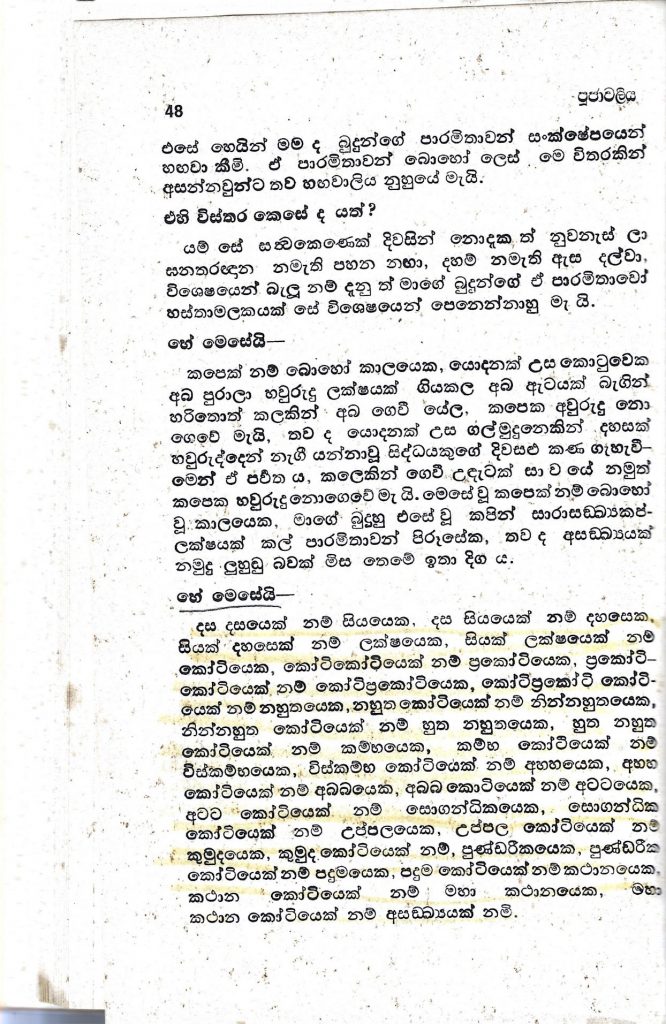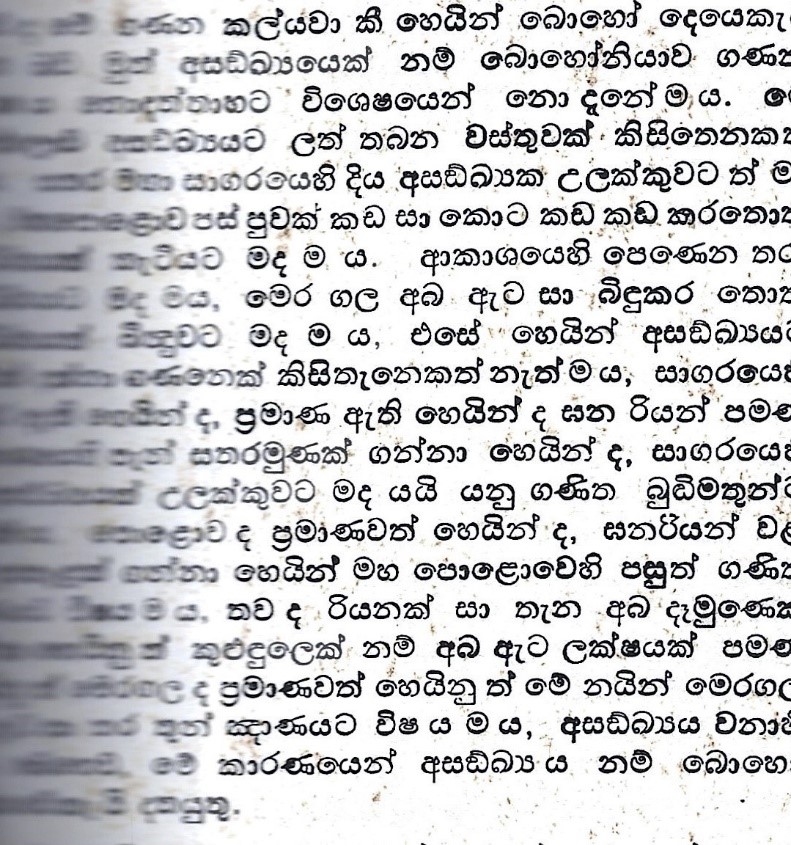Harsha Wijayawardhana,
B.S. in Biochemistry (Miami), CITP (UK), FBCS (UK)
Abstract
There is ample evidence that ancient Sinhala people had known the concept of zero and zero placeholder. Until the author presented that the Sinhala people had used a symbol for zero, most European scholars believed that Sinhala mathematics did not have a zero. This paper will explore some of the references made to zero in the Sinhala religious text, Pujavaliya, and on large numbers running to more than Googol (10100). Also, when studying carefully, there is evidence that the Pujavaliya author not only had used zero in his explanations in the text, but he presents the notion of the concept of limits in Differential Calculus approaching zero. Also, there is evidence from the text that Sinhala mathematicians, whom the author of Pujavaliya refers to as experts in mathematics, had used zero as an independent number.
Introduction
Pujavaliya is a Sinhala classic written extolling the Araham (අරහං), one of the nine epithets of the Buddha, in the thirteenth century. The author was the resident monk of the Mayurapada Pirivena or the Mayurapada Monastry and was known as Buddhaputhra Sthivara (monk). He wrote Pujavalaiya during the period between 1266 and 1275 AD at the invitation of the Prime Minister, Deva Raja, of Parakaramabahu, the King of Sri Lanka, in the Dambadeniya period. The book contains the collection of tales of the Buddha and many of his followers, arranged in thirty-four chapters.
Scholars credit the author for writing several other books, such as Yogavarnama, book on Medicine and Rathnavali, another book on Practical Medicine, Astrology, and prescriptions for drugs concealed by the medical practitioners of his day.
Mayurapada Sthivara, whose real name was not known, was considered an expert who excelled in several fields such as astrology, medicine, alchemy, and the occult sciences of his day. He belonged to the lineage of Shariputra Sangaraja of the Polonnaruwa period. And further, according to some scholars, Mayurapada Sthivara belonged to the Mahayana tradition in Sri Lanka. His writings do not provide any clues that he belonged to Mahayana tradition deviating from the Mahavira tradition, which most scholars had accepted in his day as the norm.
As the quantum of work, the author himself claims that Pujavaliya has thirty-four chapters, ninety-six discourses, twenty-four thousand tales, and seven hundred thousand sixty thousand characters. The author of Pujavaliya uses large numbers freely throughout the text in describing distances, populations, etc. Some numbers are larger than the present-day Googol, which is 10100 (Asamkhaya –10133 ). In the present context, Googolplex (1010100) is the largest number written, which is ten times Googol.
Large Numbers found in the Pujavaliya
The figure 1 contains the scanned page 48 of Pujavaliya and the highlighted area with the yellow marker provides the numbers in words starting from the number Ten to Asamkhaya (10133). According to the Indian tradition, Asamkhaya is given as 10140. Mahavamsa including Chulavamsa and Amawatura (Flood of Ambrosia by Gurulugomi, written in the 10th century) contain large numbers not as prevalent as Pujavaliya. Also, Pujavaliya defines the large numbers before its author uses them in the text.

Figure 1Page 48 of Pujavaliya (Highlighted Area provides in word from Number Ten to Asamkhaya
| Number in world in Sinhala | As 10th Power In Pujavaliya | Indian Name | As 10th Power in the Indian Tradition |
| Seeaya (Hundred) | 102 | 102 | |
| Dahasa(Thousand) | 103 | Sahastra | 103 |
| Laksha(Lak or Hundred Thousand) | 105 | Laksa | 105 |
| Koti (Crore or Ten Million) | 107 | Koti | 107 |
| Prakoti(One Hundred Trillion) | 1014 | Pakoti | 1014 |
| Koti-Prakoti(One Sextillion) | 1021 | Kotippkoti | 1021 |
| Nahuthaya(Ten Octillion) | 1028 | Nahuta | 1028 |
| Ninnahuthaya(One Hundred Decillion) | 1035 | Ninnahuta | 1035 |
| Huthanahuthaya(One Tredicillion) | 1042 | Akkahobini | 1042 |
| Kambha(Ten Quindecillion) | 1049 | Bindu | 1049 |
| Wiskambahya(One Hundred Septendecillion) | 1056 | Abbudaa | 1056 |
| Ahahayaka(One Vigintillion) | 1063 | Nirabbudda | 1063 |
| Ababayaka(Ten Duovigintillion) | 1070 | Ahaha | 1070 |
| Atatayaka(One Hundred Quattuorvigintillion) | 1077 | Ababa | 1077 |
| Sogandiyaka(One Septenvigintillion) | 1084 | Atata | 1084 |
| Upapalyaka(Ten Novemvigintillion) | 1091 | Soganghika | 1091 |
| Kumuduyaka(One Hundred Untrigintillion) | 1098 | Uppala | 1098 |
| Pundariyaka(One Quattuortrigintillion) | 10105 | Kumuda | 10105 |
| Padumayaka(Ten Sextrigintillion) | 10112 | Pundarika | 10112 |
| Kathanayaka(One Hundred Octatrigintillion) | 10119 | Paduma | 10119 |
| MahaKathanayaka(One Unquadragintillion) | 10126 | Kathana | 10126 |
| Asamkhaya(Ten Trequadragintillion) | 10133 | MahaKathana | 10133 Sri Lankan Tradition |
| One Hundred Quinquadragintillion | 10140 | Asamkhaya | 10140 Indian tradition |
Figure 2 Table of large numbers in Pujavaliya with the Indian equivalent
Significance of the Sinhala Zero and Proof for the Largeness of Asamkhaya
The author of Pujavaliya uses the word ‘Sunaya’ on many occasions in the text. Sunaya does not convey to the reader the number zero, instead, it indicates voidness or emptiness. Words, Buddha Sunaya (බුද්ධ ශුන්ය), mean a period devoid of a Buddha.
On page 49, the author argues that an Asamkhaya is a large number. To prove his argument, he brings several abstract arguments. The author argues that the number of stars in the sky is less than an Asamkhaya. He further adds to the argument by stating that water in all four oceans (Ancient Sri Lankans believed that there were only four oceans) in the world is not sufficient to fill an Asamkhaya number of containers. He continues to argue in the same passage that all soil on earth is not enough to clump into creating an Asamkhaya number of clods or lumps.
The author of Pujavaliya in the same paragraph states if mount Meru breaks or pulverizes into small pieces equivalent to mustard seeds and the number of seeds would be less slightly by a ‘Binduwa’ or a zero in Sinhala to an Asamkhaya. As pointed out earlier, Mayurapada Sthivira makes a clear distinction between the two words: Sunaya and Binduwa. He uses the word, Sunaya, to indicate emptiness or voidness. While the author uses the Sinhala word for zero, Binduawa, to denote a number with a zero value. The statement that the number of seeds would be less slightly by a Binduwa has the following observations:
- The above statement is a piece of clear evidence that Sinhala Mathematicians had treated Binduwa (Sinhala Zero) as a number individually.
- It also gives the idea that Sinhala Mathematicians had understood the modern concept of limit concept in integral calculus where any Delta variable with an infinitesimal- value (approaching zero).
The passage also confirms that Sri Lanka had experts in Mathematics who were known as Ganithayas, who performed calculations using above mentioned fundamental principles in Mathematics.

Figure 3Section of Page 49 Pujavaliya (Proof to show Asamkhaya is a large number
Conclusion
Indian mathematicians had dealt with large numbers for many centuries before other cultures. Greeks would have been the other culture that would have come closer. Indian mathematicians are credited with the introduction of zero to the world and the zero placeholder concept. It can be surmised that those ideas would have come to Sri Lanka with Buddhism and Sri Lankans seem to have had the penchant for dealing with large numbers as well. It is also possible that Sri Lankan mathematicians would have also contributed to the development of Indian Mathematics since we know that Sri Lanka had many well-known Ganithayas. Having studied Pujavaliya closely, Buddhaputhra Sthivara of Mayurapada Pirivena seemed to have well versed in the use of large and small (fractions) numbers. His argument that Asamkhaya is a large number and all the matter in the universe is less than the above still holds at present. It is accepted that all particles in the observable universe are roughly 3.28 * 1080. It is amazing that the author’s deep understanding of the nothingness (Sunaya) and infinitesimal concept, which he associates with the Sinhala zero.
Indian mathematicians like Vara Mihira I and II, Aryabatta, and Parashara had a great impact on the development of Sri Lankan astrology and astrological calculations. Some of the above great men discovered Integral calculus independently in India before Leibniz and Newton. Since Buddhaputra Sthivira mentions Ganithayas freely, and him being an accomplished astrologer himself, I am convinced that he would have had a great understanding of the early development of Integral and differential Calculus in India.
References:
- Buddhaputhra Sthivira of Mayurapada Pirivena, Pujavaliya
- Gurugomi, Amawatura
- Rajavaliya
- Mahanama Sthivira, Mahavamsa
- https://lcn2.github.io/mersenne-english-name/tenpower/tenpower.html
- https://en.wikipedia.org/wiki/History_of_large_numbers
- https://en.wikipedia.org/wiki/Largest_known_prime_number

